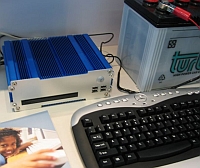In the recent BusinessWeek article "A Crusade to Connect Children", journalist Bruce Einhorn was able to garner several choice quotes from Dan Shine, Project Director of AMD's 50x15 Initiative.
Dan also happens to be the key liaison for the One Laptop Per Child project within AMD since it dovetails so nicely with the 50x15 Initiative's goal of getting half the world online by 2015.
Dan fully sports the OLPC apparently, though I have to question his knowledge of the project and developing world computing in general. First off he bashes conventional notebook computers by saying:
"Here in the U.S. we are seeing just last weekend a $399 laptop after rebate, with Windows. So people are saying why don't we just do that," says Shine. "But laptops are problematic. If any part breaks, the whole thing is broken."Yes, that's very true Dan. And so too with the OLPC laptop computers, they will also break and be damaged, but as of yet there is no spare parts distribution plan or maintenance and support network or even training courses. So while those $399 laptops can be repaired at local computer companies, where with the OLPC computer be fixed? And who will pay for that?
Payment is not something Dan Shine is concerned with. Mr. Einhorn paraphrases Mr. Shine's cost concerns as:
Moreover, [Shine] says, a PC that costs $400 in the U.S. could cost hundreds of dollars more in a developing country once you factor in taxes, transportation, and other costs.And the One Laptop Per Child starts at $140 million dollars, shipping not included. Not to mention maintenance and support, which isn't developed and may not even be offered.
Most glaringly, Dan Shine, who should know all about computers suitable for the developing world, presents the OLPC laptop as the only possible solution to power-scarce situations when he says:
"Some are based on tech that is a lot older and suck a lot of power," says Shine. "In some places, power will be generated from car batteries, cranks, or solar. It's an ongoing challenge and opportunity to look at these environments and calculate what the solutions are."Hey, Dan, you may be surprised, but there are several power-sipping solutions on the market, a few even using AMD processors. Have you ever heard of Inveneo?
You should as they are working with 50x15 to install your three digital inclusion programs with NEPAD and the Ugandan government and they already have a solar-powered PC and communications system for rural and remote communities that runs on AMD processors.
Then there is VIA Technologies, AMD's competition, who developed the hot PHD Appliance as part of its PC-1 Initiative.Note that the PHD Appliance is a fully functional computer, one that could replace any normal desktop, or integrated into a off-the-shelf laptop, and yet can run Windows XP for 26 hours off a car battery.
That would be production level technology, not the still-prototype OLPC CM1.




"Note that the PHD Appliance is a fully functional computer."
Lets see:
Not a laptop
Not kidproof
No cameras
Using a CRT screen will eat a car battery in about 5 hours, or are they going to double the cost with a lcd?screen.
The two projects are barely comparable.